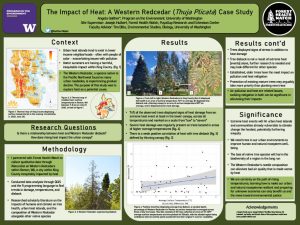The Impact of Heat: A Western Redcedar (Thuja Plicata) Case Study
Although climate change poses a risk to human wellbeing, the heat events and droughts it brings are a threat to some of the most ecologically and culturally significant Native trees in the Pacific Northwest. The purpose of this study is to understand whether heat is correlated with tree dieback – or progressive death – of the Western Redcedar, the primary species of concern today for Forest Health Watch, a non-profit organization focused on supporting healthy forests. My internship focused on the urban forest and involved utilizing Geographic Information Systems (GIS) with public city databases to understand average heat temperatures across Renton, as a proxy for the Pacific Northwest region. I selected a random sample of Western Redcedars within the city to visit and assess across areas within a range of average temperatures. The resulting data was shared on iNaturalist and analyzed for trends in damage and site characteristics through GIS and the R coding language. The findings show there is indeed a correlation between areas of high temperature and increased Western Redcedar dieback. Moving forward, future research should focus on the specific mechanics of climate change that contribute to dieback and how to improve resilience for Western Redcedar and other urban tree species. For example, solutions may include rethinking green infrastructure (how trees are included in landscape architecture) and methods to decrease urban heat. These findings are significant due to the number of well established urban trees that are removed, often disproportionately in communities already vulnerable to climate change.
